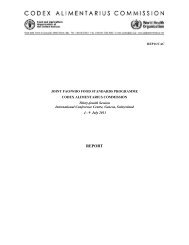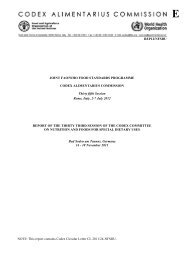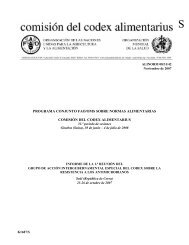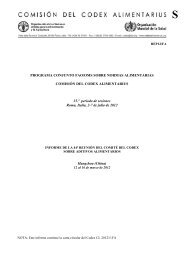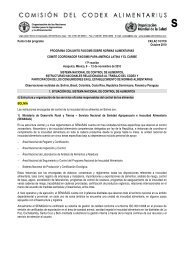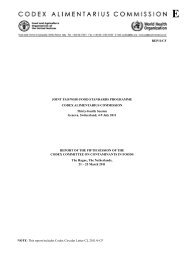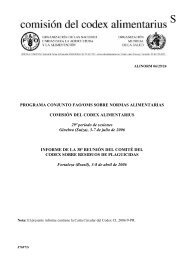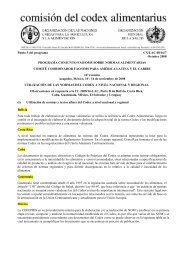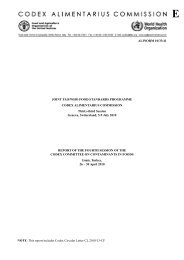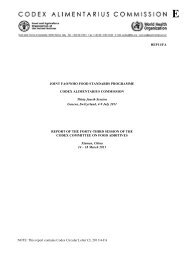Agenda Item 9 (a) CX/FA 12/44/16 February 2012 JOINT ... - FAO.org
Agenda Item 9 (a) CX/FA 12/44/16 February 2012 JOINT ... - FAO.org
Agenda Item 9 (a) CX/FA 12/44/16 February 2012 JOINT ... - FAO.org
You also want an ePaper? Increase the reach of your titles
YUMPU automatically turns print PDFs into web optimized ePapers that Google loves.
E<strong>Agenda</strong> <strong>Item</strong> 9 (a) <strong>CX</strong>/<strong>FA</strong> <strong>12</strong>/<strong>44</strong>/<strong>16</strong><strong>February</strong> 20<strong>12</strong><strong>JOINT</strong> <strong>FA</strong>O/WHO FOOD STANDARDS PROGRAMMECODEX COMMITTEE ON FOOD ADDITIVESForty-fourth SessionHangzhou, China <strong>12</strong>-<strong>16</strong> March 20<strong>12</strong>PROPOSALS FOR ADDITIONS AND CHANGES TO THE PRIORITY LIST OF FOOD ADDITIVEPROPOSED FOR EVALUATION BY JEC<strong>FA</strong> (REPLIES TO CL 2011/8-<strong>FA</strong>)The following comments have been received from the following Codex members and observersAustralia, Colombia, European Union and JapanAUSTRALIAAustralia is pleased to respond to CL 2011/8-<strong>FA</strong> by requesting Advantame be considered for inclusion in the CC<strong>FA</strong>’spriority list of compounds proposed for evaluation by JEC<strong>FA</strong> at the <strong>44</strong> th session of CC<strong>FA</strong>. This request is for the safetyassessment and establishment of specifications for Advantame.Australia believes that its nomination meets the criteria elaborated in Annex 1 of CL 2011/8-<strong>FA</strong> for inclusion in thepriority list. Accordingly we have completed Annex 2 (“Form on which information on the compound to be evaluatedby JEC<strong>FA</strong> is provided”) for Advantame, as prescribed in CL 2011/8-<strong>FA</strong>.Annex 2: INFORMATION ON THE COMPOUND TO BE EVALUATED BY JEC<strong>FA</strong>Name of CompoundAdvantameQuestions to be answered by JEC<strong>FA</strong>Safety assessment and establishment of specifications1. Proposal for inclusion submitted by:Australia2. Name of compound; trade name(s); chemical name(s):Advantame; {N-[N-[3-(3-hydroxy-4-methoxyphenyl) propyl--aspartyl]-L-phenylalanine 1-methyl ester,monohydrate; CAS No. 714229-20-6}3. Name and address of basic producers:Ajinomoto Co. Inc.15-1 Kyobashi 1-Chome, Chuo-KuTokyo 104-83154. Has the manufacturer made a commitment to provide data:Yes5. Identification of the manufacturer that will be providing data (Please indicate contact person):Akira Otabe, Ajinomoto Co. Inc.6. Justification for use:Advantame is used in foods to provide high intensity sweetness while maintaining their flavour integrity. Inaddition, when used at a low level, Advantame also enhances existing flavour of food.7. Food products and food categories within the GS<strong>FA</strong> in which the compound is used as food additive or as aningredient, including use level(s):
<strong>CX</strong>/<strong>FA</strong> <strong>12</strong>/<strong>44</strong>/<strong>16</strong> 3Other information as necessaryHuman studies10. Date on which data could be submitted to JEC<strong>FA</strong>: ImmediatelyCOLOMBIABackground: The JEC<strong>FA</strong> Secretariat presented the paper <strong>CX</strong>/<strong>FA</strong> 11/43/19 and recalled that the JEC<strong>FA</strong> and the CC<strong>FA</strong>had repeatedly discussed the need for a more systematic approach to the re-evaluation of food additives that is nowbeing carried out in response to specific requests. Colombia presents to the Codex Committee on Food Additives andJEC<strong>FA</strong> a request for inserting Polyglycerol polycirinoleate (PGPR) in the GS<strong>FA</strong>.A completed form is attachedFORM ON WHICH INFORMATION ON THE COMPOUND TO BE EVALUATED BY JEC<strong>FA</strong> ISPROVIDEDIn completing this form, only brief information is required. The form may be retyped if more space is needed under anyone heading provided that the general format is maintainedName of compound(s):Polyglycerol polycirinoleate (PGPR)Question(s) to be answered by JEC<strong>FA</strong>1. Proposal for inclusion submitted by: COLOMBIA2. Name of compound; trade name(s); chemical name(s) Glycerol esters of condensed castor oil of fatty acids (Ricinus communis L) Polyglycerol esters of interesterified ricinoleic acid. 9-octadecenoic acid, <strong>12</strong>-hydroxy-, (9Z, <strong>12</strong>R)- polymer with 1,2,3-propanetriol. CAS 29894-35-7 INS 476 The major components have the general structure:where the average value of n is about 3 and R 1 R 2 and R 3 each may be hydrogen or a linear condensation polymer ofricinoleic acid with itself thus:Where the average value of m is between 5 and 83. Names and addresses of basic producers:DANISCO COLOMBIA LTDA – Carrera 90 A No. 64C-54 Bogotá COLOMBIA – Tel +57 1 4251510.4. Has the manufacturer made a commitment to provide data?YES
<strong>CX</strong>/<strong>FA</strong> <strong>12</strong>/<strong>44</strong>/<strong>16</strong> 45. Identification of the manufacturer that will be providing data (Please indicate contact person): Deltagen Group, manufacturer of PGPR, has the representations for Colombia, Ecuador, Peru and Venezuela.Name: Savannah SurfactantsPhone: +91 832 2395109Address: 283A Kundaim Ind EstateE mail: a.bajaj@savannahgoa.comContact person: Ani Bajaj In Colombia: Dr. GLORIA MARIA VELASCO- SPECIAL PROJECTS DIVISION DELTAGEN SAS. E mail:gloriav@deltagenbiop.com6. Justification for use:PGPR is a mixture of partial esters of polyglycerol with linear sterified fatty acids (ricinoleic acid). The polyglycerolfraction is mostly di-, tri- and tetraglycerol.PGPR is used to modify the fluidity properties of chocolate and because it is an efficient surfactant for stabilizing oilin water emulsions, such as spreads with low fat content. In addition, it acts as a viscosity modifier in chocolateproducts and cacao based products, and with Lethicin it has a synergistic effect, which has a beneficial influence onthe plastic viscosity. The use of PGPR allows reducing the fat levels in the product.On the other hand, PGPR differs positively from other emulsifiers due to its singular yield value which reduces itscapacity and ability to counteract the negative effect of moisture on chocolate covers for ices.7. Food products and food categories within the GS<strong>FA</strong> in which the compound is used as a food additive or asan ingredient, including use level(s):a. Standard for Chocolate and Chocolate Products (CODEX STAN 87): Maximum level: 5 g/kg (Productsdescribed under 2.1 and 2.2 in the commodity standard)b. Standard for Cacao powders (cocoas) and dry mixtures of cocoa and sugars (CODEX STAN 105-1981,REV 1-2001): Maximum level: 5 g/kgc. Standard for fat spreads and blended spreads (CODEX STAN 256-2007): Maximum level: 4000 mg/kg (4g/kg)Table 2 of the GS<strong>FA</strong> proposed for discussion (foods or food categories where the use of additives is allowed), liststhe additive polyglycerol esters of interesterified ricinoleic acid for the food categories: Cocoa mixes (powders) andcocoa mass/cake05.1.1 Cocoa mixes (powders) and cocoa mass/cake.05.01.4 Cocoa and chocolate products.05.1.5 Imitation chocolate, chocolate substitute products.All of them with a maximum level of 5000 mg/kg.8. Is the compound currently used in food that is legally traded in more than one country? (Please identify thecountries); or, has the compound been approved for use in food in one or more country? (Please identify thecountry(ies)).The additive PGPR is approved in legislations of several Latin American countries: Colombia, Venezuela, Ecuador,Paraguay, Argentina, México, Peru (see attached file). Additionally it is regulated by EUROPEAN PARLIAMENTAND COUNCIL DIRECTIVE No 95/2/EC of 20 <strong>February</strong> 1995 at a maximum level of 5 g/kg (See PDF directive,page 48/68) and by the FDA Gras Notice 000009 at a maximum level of 3 mg/kg (See PDF GRAS)The support documents and access links to web pages are available at the followinglink: ftp://ftp.fao.<strong>org</strong>/codex/ccfa<strong>44</strong>/fa<strong>44</strong>_<strong>16</strong>_worksheet.pdf9. List of data available (please check, if available). Toxicological data(i) Metabolic and pharmacokinetic studies.(ii) Short-term toxicity, long-term toxicity/carcinogenicity, reproductive toxicity, and developmental toxicitystudies in animals and genotoxicity studies.(iii) Epidemiological and/or clinical studies and special considerations.
<strong>CX</strong>/<strong>FA</strong> <strong>12</strong>/<strong>44</strong>/<strong>16</strong> 5(iv) Other data. JEC<strong>FA</strong> monograph (INS 476)http://www.fao.<strong>org</strong>/ag/agn/jecfa-additives/specs/Monograph1/Additive-318.pdf Manufacturer PGPR technical file with technical/toxicological data available at:(ftp://ftp.fao.<strong>org</strong>/codex/ccfa<strong>44</strong>/fa<strong>44</strong>_<strong>16</strong>_Polyglycerol polyricinoleate.pdf ) Toxicological studies (INCHEM) WHO FOOD ADDITIVES SERIES NO. 5http://www.inchem.<strong>org</strong>/documents/jecfa/jecmono/v46aje48.htm EFEMA index of food emulsifiers - September 2009 5th editionhttp://www.emulsifiers.<strong>org</strong>/files/EFEMA_Index_of_Food_Emulsifiers.pdf COMMISSION OF THE EUROPEAN COMMUNITIES - Reports of the Scientific Committee for Food -Eighth series 1979http://ec.europa.eu/food/fs/sc/scf/reports/scf_reports_08.pdf FOOD AND DRUG REGULATIONS- June 8, 2009- Published by the Minister of Justice at the followingaddress: http://laws-lois.justice.gc.caTechnological data(i) Specifications for the identity and purity of the listed compounds (specifications applied during developmentand toxicological studies; proposed specifications for commerce)(ii) Technological and nutritional considerations relating to the manufacture and use of the listed compoundIntake assessment data(i) Levels of the listed compound used in food or expected to be used in food based on technological function andthe range of foods in which they are used(ii) Estimation of dietary intakes based on food consumption data for foods in which the compound may be used.The acceptable daily intake (ADI) of PGPR which is widely used in confectionery, especially in chocolatecoatings, is 75 mg/Kg of weight.Other information as necessary:Document of reference: Directive 95/2/EC on food additives other than colours and sweeteners that establishesa list of allowed food additives, the commodities where they can be used and conditions of their use.This Directive was adopted in <strong>February</strong> 1995 and has been amended three times: in 1996, 1998 and 2001. Now itneeds to be adapted according to the most recent developments of technical and scientific knowledge. The aim ofthis proposal is ensuring the functioning of the internal market, a high level of protection of human health andthe protection of consumer interests:Number 3. Authorization for extending the use of authorised food additivesFood additives with ADI «not specified». Two viscosity parameters are used in chocolate processing to ensureoptimal processing and eating quality. Yield value is the minimum amount of force required to produce a flow.Plastic viscosity describes the flow characteristics once the flow has been initiated. Both yield value and plasticviscosity can be influenced by adding more fat. Since fat, and especially cocoa butter, is the most costly part ofchocolate, it is desirable to influence these rheological properties by means of emulsifiers.Emulsifiers with an effect on rheological properties of chocolate include E 322 lecithin, E <strong>44</strong>2 ammoniumphosphatides, E 476 polyglycerol polyricinoleate and E 472c citric acid esters of which all but E 472c arecurrently allowed for chocolate within the EU. When affecting both yield value and plastic viscosity, they can be used as the sole alternative to the combineduse of lecithin/ammonium phosphatide and polyglycerol polyricinoleate thereby reducing the number ofemulsifiers in certain products.10. Date on which data could be submitted to JEC<strong>FA</strong>: <strong>February</strong> 20<strong>12</strong>
<strong>CX</strong>/<strong>FA</strong> <strong>12</strong>/<strong>44</strong>/<strong>16</strong> 6EUROPEAN UNIONThe European Union and its Member States (EUMS) would like to submit the substance "Glucoamylase fromTrichoderma reesei , TrGA" for addition to the priority list of food additives proposed for evaluation by JEC<strong>FA</strong>:FORM ON WHICH INFORMATION ON THE COMPOUND TO BE EVALUATED BY JEC<strong>FA</strong> ISPROVIDEDIn completing this form, only brief information isrequired. The form may be retyped if more space isneeded under any one heading provided that the generalformat is maintained. Name of Compound(s):Question(s) to be answered by JEC<strong>FA</strong>(kindly provide a brief justification of the request in caseof re-evaluations)Glucoamylase from Trichoderma reesei expressed inTrichoderma reesei1. Proposal for inclusion submitted by:European Union and its Member States2. Name of compound; trade name(s); chemical name(s):Compound: Glucoamylase enzyme produced by a non-pathogenic, non-toxigenic strain of Trichoderma reesei(formerly Trichoderma longibrachiatum), which is genetically modified to over express a native T. reesei glucoamylaseenzyme.[In this document TrGA is used as a code for the specific enzyme, which is an abbreviation for Trichoderma reeseiGlucoAmylase.]Trade name: DISTILLASE and DIAZYME (main commercial name)(various other commercial names will be used, like DISTILLASE CS, DISTILLASE ASP, DISTILLASE SSF,DIAZYME TGA, DIAZYME SG2, DISTILLASE ASP NK, DISTILLASE SSF +, DIAZYME SSF2)Chemical name: CAS 9075-68-7, EC 3.2.1.33. Names and addresses of basic producers:Danisco US, Inc.Genencor, a Danisco Division200 Meridian Centre Blvd.Rochester, NY 14618-39<strong>16</strong>USA4. Has the manufacturer made a commitment to provide data?Genencor, a Danisco Division, commit to provide data to support the proposal for inclusion of the glucoamylase in thelist of substances to be evaluated by JEC<strong>FA</strong>.5. Identification of the manufacturer that will be providing data (Please indicate contact person):Danisco US, Inc.Genencor, a Danisco Division200 Meridian Centre Blvd.Rochester, NY 14618-39<strong>16</strong>USAAttn.: Lone Brønd Miller Ph.D., Sr Regulatory Specialistlone.broend.miller@danisco.com+45 8943 53546. Justification for use:Glucoamylase (GA) causes hydrolysis of terminal 1,4-linked a-D-glucose residues successively from non-reducing endsof the chains with release of b-D-glucose.
<strong>CX</strong>/<strong>FA</strong> <strong>12</strong>/<strong>44</strong>/<strong>16</strong> 7It can also hydrolyze 1,6-a-D-glucosidic bonds when the next bond in the sequence is 1,4.The glucoamylase enzyme preparation will be used as a processing aid to hydrolyze starch, e.g., for syrup, dextrose ormaltose production and in grain processing, brewing, potable alcohol and baking.In grain processing/sweeteners production glucoamylase is used to sacccharify liquefied starch resulting in glucose-richsyrups. The syrups can be purified to meet various specifications: crystallized to produce dextrose, isomerized toproduce high fructose corn syrup, or fermented to produce <strong>org</strong>anic acids, alcohol or amino-acids.In brewing and potable alcohol glucoamylase is used to maximize the conversion of starchy substrate to fermentablecarbohydrate increasing production yield.In baking glucoamylase gives control over the carbohydrate profile. It will reduce or replace the need to add simplesugars to the formulation and in addition it will reduce firming caused by starch retrogradation.A more thorough description of the various application processes and fate of the glucoamylase will be presented in finaldossier.7. Food products and food categories within the GS<strong>FA</strong> in which the compound is used as a food additive or as aningredient, including use level(s):Grain processing/sweeteners production, i.e. starch saccharification – glucoamylase is used at a level of 31 – 77 genzyme protein per metric ton of starch dry substance, in accordance with current Good Manufacturing Practices(cGMPs)Brewing and Potable Alcohol, i.e. extraction and saccharification of starch and conversion of starchy substrate tofermentable carbohydrate – glucoamylase is used at a level of 387 - 774 g enzyme protein per metric ton of grist (e.g.malted barley) in brewing. For potable alcohol, the dose level is <strong>44</strong> – 77 g enzyme protein per metric ton of equivalentstarch dry substance (or approximately 93 - 155 g enzyme protein per metric ton of equivalent grist), in accordance withcurrent Good Manufacturing Practices (cGMPs).Baking, i.e. hydrolysis of starch and starch-derived carbohydrates into glucose and reduction of retrogradation –glucoamylase is used at a level of 0.0155 – 0.310 mg enzyme protein per g of flour, in accordance with current GoodManufacturing Practices (cGMPs).8. Is the compound currently used in food that is legally traded in more than one country? (please identify thecountries); or, has the compound been approved for use in food in one or more country? (please identify thecountry(ies))Glycoamylase produced with this production <strong>org</strong>anism is approved in:Denmark: Ministry of Food, Argriculture and Fisheries, Danish Veterinary and FoodAdministration, File No 2011-20-5406-00036 (October 13, 2011). USA: Department of Health & Human Services, Public Health Service,Food and Drug Administration, GRN 000372 (July 25, 2011).http://www.accessdata.fda.gov/scripts/fcn/fcnNavigation.cfm?filter=372&sortColumn=&rpt=grasListing9. List of data available (please check, if available)The production <strong>org</strong>anism is from a safe strain lineage as described in the decision tree in Pariza and Johnson, 2001 1 ;however, to accommodate various registration requirements in different countries world-wide, a full toxicity programfor food enzymes has been performed.The safety of TrGA has been assessed in a battery of toxicology studies investigating its irritation, acute ingestion,genotoxic and systemic toxicity potential.Toxicological data(i) Metabolic and pharmacokinetic studiesNot applicable.(ii) Short-term toxicity, long-term toxicity/carcinogenicity, reproductive toxicity, and developmental toxicity studiesin animals and genotoxicity studies1 Pariza MW, Johnson EA; Evaluating the safety of microbial enzyme preparations used in food processing: update fora new century; Regul Toxicol Pharmacol 2001 Apr;33(2):173-86.
<strong>CX</strong>/<strong>FA</strong> <strong>12</strong>/<strong>44</strong>/<strong>16</strong> 9In baking the temperature in the center of the bread goes above 90ºC and above 110 ºC at the surface of thebread. Considering the Tm value of TrGA is 74º C, it is expected that TrGA will be inactivated.A more thorough description of the various application processes and fate of the glucoamylase will be presentedin final dossier.Intake assessment data(i) Levels of the listed compound used in food or expected to be used in food based on technological function andthe range of foods in which they are used1. Grain processing/sweeteners production – 0.047 mg enzyme protein/gIn this assessment, an application rate of 47 g enzyme protein per metric ton of starch dry substance used torepresent a worst2. Brewing – 0.132 mg enzyme protein/ml of beerIn this assessment, an application rate of 774 g enzyme protein per metric ton of grist is used to represent aworst case scenario.3. Potable Alcohol – 0.<strong>12</strong>0 mg enzyme protein/ml of potable alcoholIn this assessment, an application rate of 77 g enzyme proteinProduct per metric ton of equivalent starch dry is used to represent a worst case scenario.4. Baking - 0.204 mg enzyme protein/g of breadIn this assessment, an application rate of 0.310 mg enzyme protein per g of flour used to represent a worstcase scenario.(ii) Estimation of dietary intakes based on food consumption data for foods in which the compound may be used.Although it is expected that residues of a processing aid in the final products would be inactivated and negligibleafter processing, a worst-case-scenario approach is used in this risk assessment assuming that:(1) 100% of the above commodities are treated with TrGA enzyme product(2) Human’s consumption consists of only commodities treated with TrGA(3) 100% of TrGA is not removed during processingMaximum Daily Exposure to TrGA =0.065 mg enzyme protein/kg bw/day from all sweeteners0.495 mg enzyme protein/kg bw/day from brewing0.027 mg enzyme protein/kg bw/day from potable alcohol0.832 mg enzyme protein/kg bw/day from bakeryTotal = 1.419 mg enzyme protein /kg bw/day from all commoditiesA more in dept presentation and explanation of the calculations, the data and references will be included inthe final dossierOther information as necessaryNone.10. Date on which data could be submitted to JEC<strong>FA</strong>:November 20<strong>12</strong>
<strong>CX</strong>/<strong>FA</strong> <strong>12</strong>/<strong>44</strong>/<strong>16</strong> 10JAPANIn completing this form, only brief information is required. The form may be retyped if more space is needed under anyone heading provided that the general format is maintained.Name of Compound(s):Annatto extracts, bixin-based (INS <strong>16</strong>0b(i)) and Annatto extracts,norbixin-based (INS <strong>16</strong>0b(ii))Question(s) to be answered by JEC<strong>FA</strong> Revision of specifications (Change of purity test and revise of specific(kindly provide a brief justification of the limits for residual solvents)request in case of re-evaluations)1. Proposal for inclusion submitted by: JAPAN2. Name of compound; trade name(s); chemical name(s):Annatto extracts, bixin-based (INS <strong>16</strong>0b(i)) and Annatto extracts, norbixin-based (INS <strong>16</strong>0b(ii))3. Names and addresses of basic producers: N.A.4. Has the manufacturer made a commitment to provide data? N.A.5. Identification of the manufacturer that will be providing data (Please indicate contact person):Dr. Hiroshi Akiyama, Head of Department of Food Additives,National Institute of Health Sciences, Tokyo JapanTEL:+81-3-3700-9484 <strong>FA</strong>X: +81-3-3700-9484 E-mail: akiyama@nihs.go.jp6. Justification for use: red/orange colorants7. Food products and food categories within the GS<strong>FA</strong> in which the compound is used as a food additive or as aningredient, including use level(s):GS<strong>FA</strong> provisions of annatto extracts are as follows.1) Annatto extracts, bixin-based (INS <strong>16</strong>0b(i)): food category: 02.2.1 (butter), use level:



